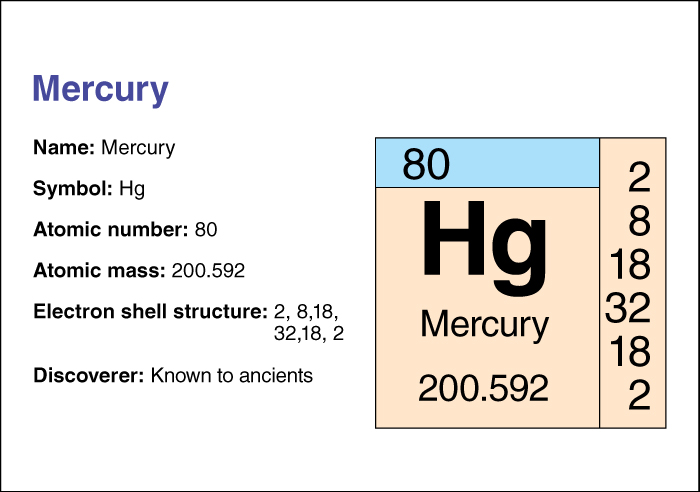Mercury is a silver-colored metallic element. Unlike all other pure metals, mercury is a liquid at room temperature. People sometimes call mercury quicksilver because it flows easily and rapidly. The ancient Chinese, Egyptians, Greeks, Hindus, and Romans knew about the metal. Its name comes from the messenger of the gods in Roman mythology. Its chemical symbol, Hg, comes from the Latin word hydrargyrum, meaning liquid silver.

Mercury’s atomic number (number of protons in its nucleus) is 80. Its relative atomic mass is 200.59. An element’s relative atomic mass equals its mass (amount of matter) divided by 1/12 of the mass of carbon 12, the most stable isotope of carbon. Mercury melts at –38.84 °C and boils at 356.58 °C.
Chemists classify mercury as a transition metal. For information on the position of mercury on the periodic table, see the article Periodic table.
Sources.
Mercury makes up less of Earth’s crust than many other metals. Most of the mercury in nature appears in the form of mercuric sulfide (HgS), which makes up the mineral cinnabar. To obtain the pure metal, refiners heat cinnabar in the presence of air. Oxygen in the air combines with the sulfur to form sulfur dioxide gas, leaving the mercury behind.

China leads the world in production of mercury. Other major producers include Argentina, Kyrgyzstan, and Tajikistan.
Properties.
Mercury has many useful properties. For example, it expands and contracts evenly when heated or cooled. It also remains liquid over a wide range of temperatures and does not stick to glass. These properties have led to its use in thermometers and barometers. Because mercury conducts electric current, it is used in electric switches and relays that operate silently and efficiently. Mercury electrodes (solid electrical conductors) have been used in a chemical-separating process called electrolysis (see Electrolysis). Mercury vapor, used in fluorescent lamps, gives off a bright light when electric current passes through it.
Mercury appears in many useful alloys (combinations of two or more metals). Mercury alloys are called amalgams. Dentists sometimes use silver amalgam, an alloy of silver and mercury, to fill cavities in teeth. Many dry cell batteries contain amalgams of zinc and cadmium.
Compounds.
Mercury forms useful compounds with other elements. Paint manufacturers use mercuric sulfide (HgS) to make a red pigment called vermilion. Mercuric oxide (HgO) is used to make mercury batteries.
Mercury and its compounds have long been known to kill bacteria and fungi. They have been used to treat syphilis and other illnesses and have appeared in antiseptics, such as Mercurochrome. Mercurous chloride (Hg2Cl2), commonly called calomel, is an antiseptic used to kill bacteria. People once treated lumber, paint, and paper with mercury to prevent the growth of fungi and treated seeds with mercury to prevent plant diseases caused by fungi. Shipbuilders used paint containing mercury to prevent marine organisms from growing on the hulls of ships. Mercury compounds were also once widely used in the manufacture of such products as house paint, paper, and leather goods.
Mercury in the environment.
The use of mercury and mercury compounds declined as physicians and scientists became increasingly aware that these substances are highly toxic. Mercury acts as a cumulative poison—that is, it collects in the body with repeated exposure until it reaches dangerous levels. It damages nerve cells, including those in the brain. People suffering from severe mercury poisoning were once thought to be insane. The expression “mad as a hatter” arose because many hat makers developed serious brain and nerve disorders from exposure to mercury in their work. They used a mercury compound, mercury nitrate, to remove fur from rabbit and beaver pelts and turn them into felt hats.
Liquid mercury is dangerous, but it is not easily absorbed through the skin or digestive system. However, a substantial amount of mercury vapor, which is extremely harmful, can accumulate in rooms where a mercury spill has occurred. Compounds in which mercury is attached to a methyl group (CH3), called methyl mercury compounds, are absorbed quickly through the skin, stomach, and intestines.
Because mercury was widely used in agriculture and industry and also occurs naturally, a considerable amount of the metal exists in the environment. Mercury compounds can become incorporated into plants and animals grown on mercury-tainted land or into fish taken from mercury-contaminated waters. Researchers have discovered poisonous mercury compounds in such foods as eggs, fish, grain, and meat. In rare instances, food supplies severely contaminated with mercury compounds have caused dozens or even hundreds of illnesses or deaths. Minimata disease is a type of mercury poisoning caused by methyl mercury compounds.
Many countries prohibit the dumping of wastes that contain mercury and limit the industrial use of mercury compounds. However, mercury still remains in the environment. Many researchers have warned people to limit their intake of some kinds of fish, including shark, swordfish, king mackerel, tilefish, and albacore (white) tuna. These fish may contain high levels of mercury or its compounds because their bodies can accumulate and concentrate the mercury present in the smaller fish that they eat.
